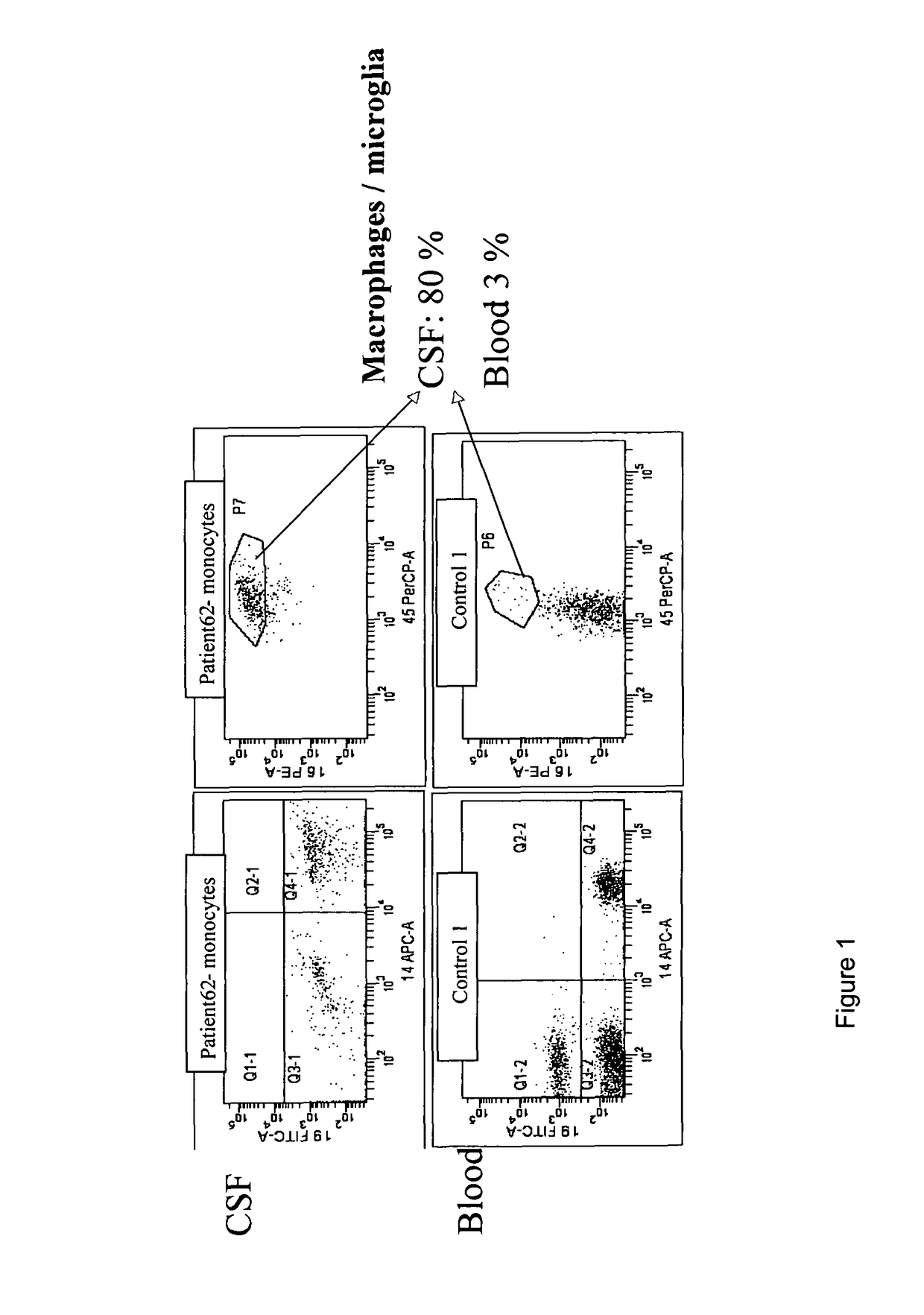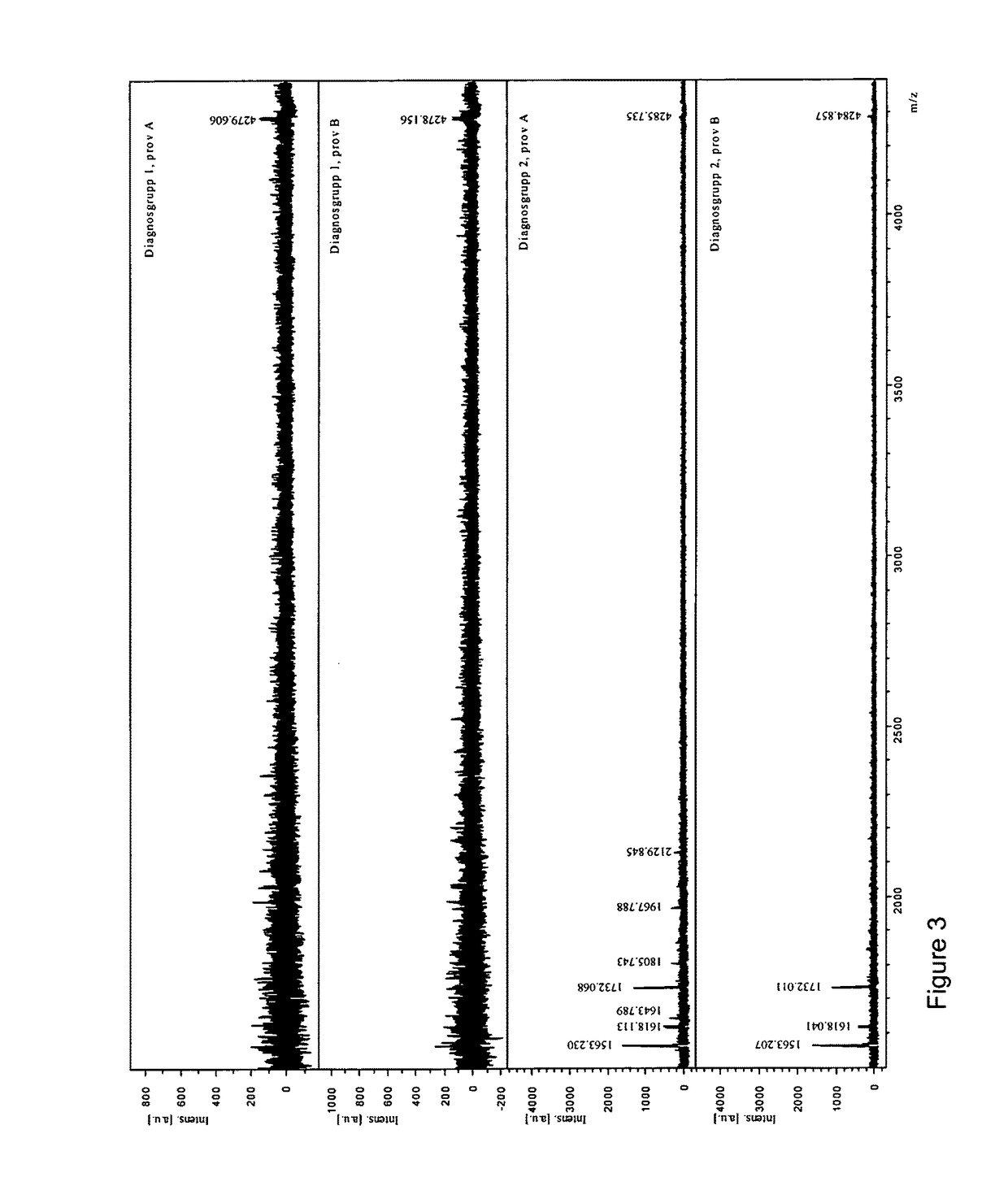Diagnostic method for Alzheimer's disease
a technology for alzheimer's and diagnosis, applied in the direction of instruments, biochemistry apparatus and processes, material analysis, etc., can solve the problems of severe burden, long course of ad, and also detrimental to health
- Summary
- Abstract
- Description
- Claims
- Application Information
AI Technical Summary
Benefits of technology
Problems solved by technology
Method used
Image
Examples
example 1
Patient Selection
[0120]Patients were ambulatory or intramural and were recruited from Nevroklinikken at Akershus University Hospital. Lumbar puncture was performed as a planned procedure. The patient groups were divided into following diagnosis: 1) probable Alzheimer's disease (AD) diagnosed according to NINCS-ADRA criteria [12]; 2) probable Multiple sclerosis (MS) diagnosed according to the McDonald criteria; 3) no nervous system disease (e.g. ME, and other patients with a full negative investigation for “organic” disease); 4) mild cognitive impairment (MCI) / non-AD; and 5) 7-10 days post-stroke patients.
example 2
Lumbar Puncture / Blood Sampling
[0121]The lumbar puncture was routinely carried out in connection with diagnosis between 0900 and 1330 hrs. CSF was obtained from patients through lumbar puncture between vertebras L4 and L5 with the patients in horizontal positions. The skin in the lumbar region was thoroughly washed with sterile cotton swabs and chlorhexidine 5%. The neurologist on call performed the lumbar puncture. Fine disposable needles were used (Becton Dickinson 20GA 3.5 IN 0.9×90 mm). The sample for flow cytometry analysis was collected as the final sample, altogether 2 mL (˜40 droplets) of CSF. The blood sample (EDTA or heparin) was taken immediately prior to or following the lumbar puncture.
[0122]Cells were acquired on a FACSAria Cell-Sorting System and analysed using FACSDiva software (both Becton Dickinson) within a maximum of four hours post puncture / blood sampling.
example 3
Preparation and Analysis of CSF / Blood Samples by Flow Cytometry
[0123]2 mL CSF and / or 4 mL blood was pelleted (4° C., 400×g, 10 min). The supernatant was removed and the remaining cell pellets were washed once with staining buffer (Becton Dickinson, San Jose, Calif.). The cell pellets were diluted in 1-2 mL of staining buffer and were centrifuged at 4° C., 400×g, 10 min. The supernatant was removed, and the sample was transferred to a flow tube. The sample was stained with a panel of fluorescent-labelled antibodies (2.5 μL CD4-FITC and CD19-FITC, 2.0 μL of CD8-PE, CD16-PE and CD45-PerCP, 1.5 μL CD3-APC and CD14-APC all from Becton Dickinson). The samples were incubated in a refrigerator for 15-20 minutes before adding 3-4 droplets of FACSFlow solution, mixed and made ready for flow cytometry analysis.
PUM
| Property | Measurement | Unit |
|---|---|---|
| concentration | aaaaa | aaaaa |
| concentration | aaaaa | aaaaa |
| pH | aaaaa | aaaaa |
Abstract
Description
Claims
Application Information
 Login to View More
Login to View More - R&D
- Intellectual Property
- Life Sciences
- Materials
- Tech Scout
- Unparalleled Data Quality
- Higher Quality Content
- 60% Fewer Hallucinations
Browse by: Latest US Patents, China's latest patents, Technical Efficacy Thesaurus, Application Domain, Technology Topic, Popular Technical Reports.
© 2025 PatSnap. All rights reserved.Legal|Privacy policy|Modern Slavery Act Transparency Statement|Sitemap|About US| Contact US: help@patsnap.com



